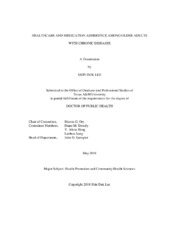| dc.contributor.advisor | Ory, Marcia G | |
| dc.creator | Lee, Shin Duk | |
| dc.date.accessioned | 2019-01-17T18:39:42Z | |
| dc.date.available | 2020-05-01T06:24:07Z | |
| dc.date.created | 2018-05 | |
| dc.date.issued | 2018-05-03 | |
| dc.date.submitted | May 2018 | |
| dc.identifier.uri | https://hdl.handle.net/1969.1/173489 | |
| dc.description.abstract | Older adults account for almost one-third of all medications prescribed in the US. Of special concerns are the high rates of medication non-adherence in this population. Understanding the drivers of the medication non-adherence among the older population can inform effective public health interventions. This dissertation is divided into three separate sections, and each section examines different determinants of the medication non-adherence.
The first section used systematic literature review and meta-analysis to describe the prevalence of medication non-adherence and overview the association between patient-provider relationship and medication non-adherence among community-dwelling older adults. Ten studies were included in this review. The mean prevalence rate of medication non-adherence was 33%. Information exchange was positively associated with medication non-adherence, but discussion about barriers was negatively associated with medication non-adherence.
The second section used multiple linear mixed-effects models to examine the long-term impacts of the Chronic Disease Self-Management Program (CDSMP) on medication non-adherence in older adults. Medication adherence did not improve significantly at the 6-month follow-up assessment (p=0.518) but improved significantly at the 12-month follow-up assessment (p=0.021). Among those with major depression at the baseline assessment, the short-term improvements in depression (p=0.002) and self-
iii
rated health (p=0.045) were associated with improved medication adherence at the 12-month follow-up assessment.
The third section used structural equation modeling to examine the causal paths between poverty, patient attitudes, and cost-related medication non-adherence (CRN). Six percent of the participants reported CRN in the past 12-months. The final model showed a good-to-fair fit. As hypothesized, the effects of poverty on CRN was mediated through the medication affordability, access to healthcare, and overall patient satisfaction.
Medication non-adherence is a complex problem that is rooted in multitudes of inter-related factors, and the three sections have examined multiple modifiable factors, suggesting several points of intervention for improving medication adherence among older adults. We call for more senior-friendly public health interventions that address the modifiable barriers (e.g., patient-provider relationship, depression, self-rated health, and patient attitudes). Future studies are needed to understand the underlying complexity and guide the future interventions. | en |
| dc.format.mimetype | application/pdf | |
| dc.language.iso | en | |
| dc.subject | Medication adherence | en |
| dc.subject | Chronic disease management | en |
| dc.subject | Older adults | en |
| dc.title | Healthcare and Medication Adherence among Older Adults with Chronic Diseases | en |
| dc.type | Thesis | en |
| thesis.degree.department | Health Promotion and Community Health Sciences | en |
| thesis.degree.discipline | Health Promotion and Community Health Sciences | en |
| thesis.degree.grantor | Texas A & M University | en |
| thesis.degree.name | Doctor of Public Health | en |
| thesis.degree.level | Doctoral | en |
| dc.contributor.committeeMember | Dowdy, Diane M | |
| dc.contributor.committeeMember | Hong, Yan A | |
| dc.contributor.committeeMember | Jiang, Luohua | |
| dc.type.material | text | en |
| dc.date.updated | 2019-01-17T18:39:42Z | |
| local.embargo.terms | 2020-05-01 | |
| local.etdauthor.orcid | 0000-0002-8773-9208 | |


